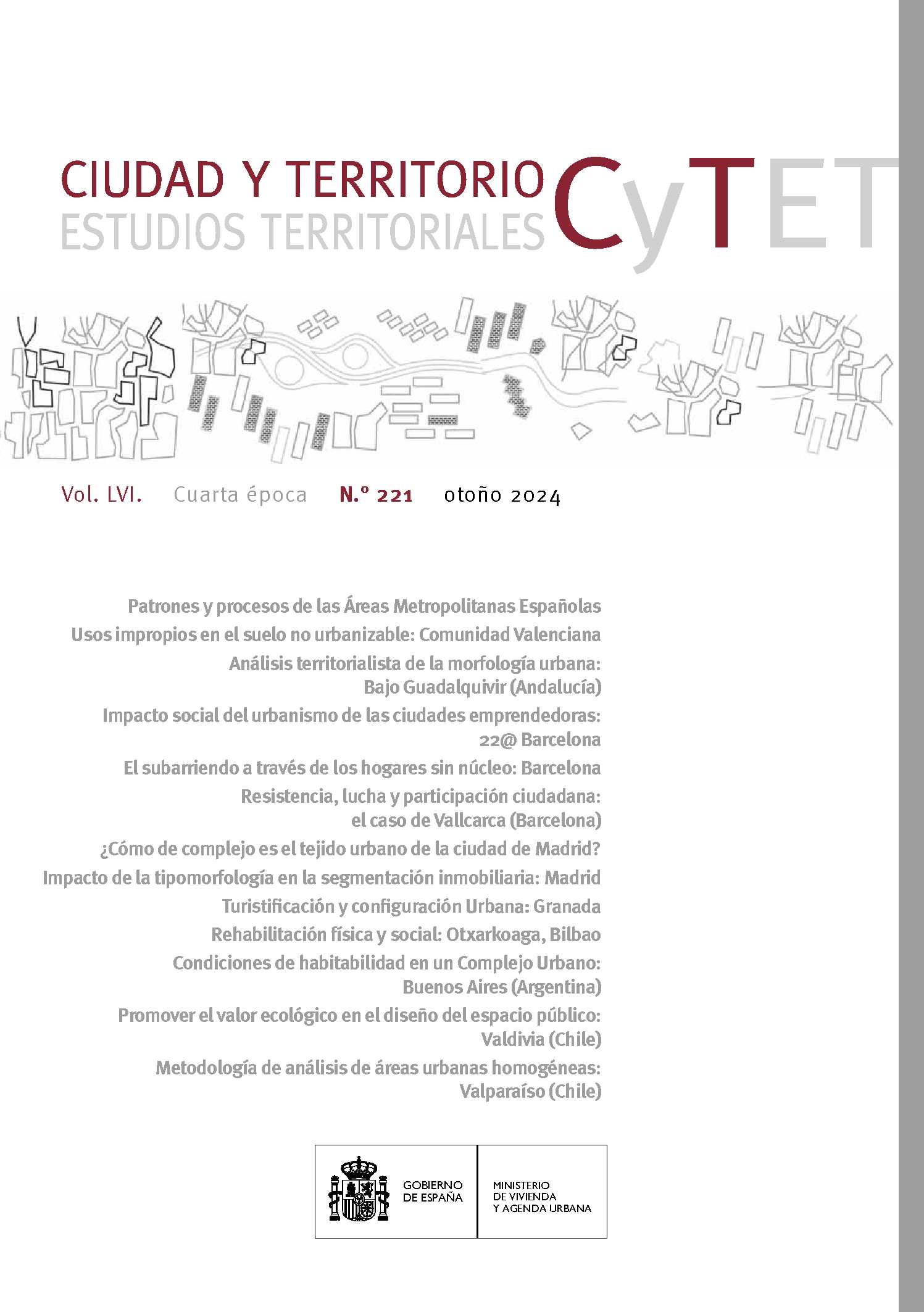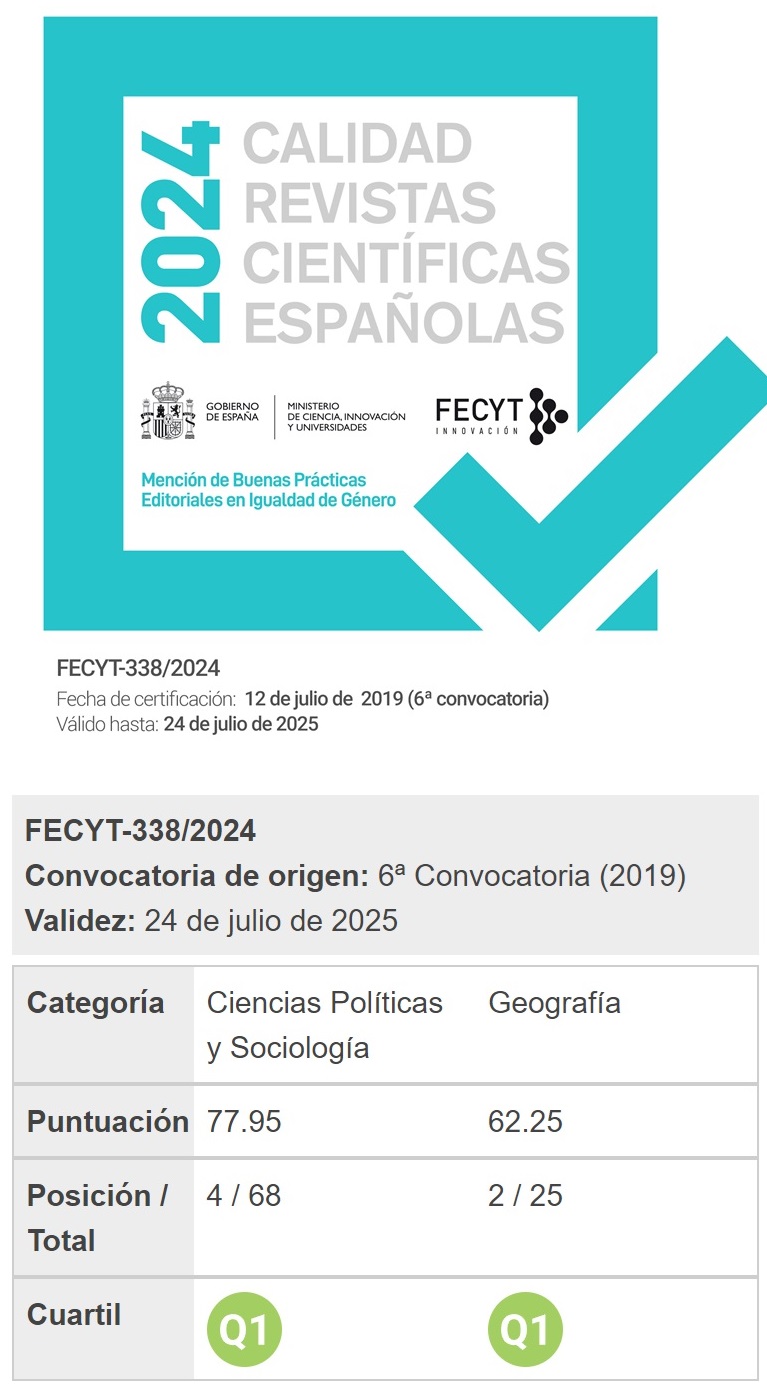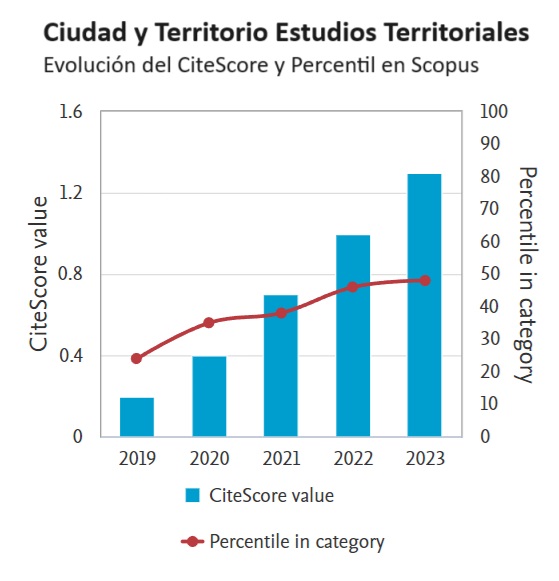Impacto de la morfología urbana en la segmentación del mercado de la vivienda: caso de estudio Madrid
DOI:
https://doi.org/10.37230/CyTET.2024.221.8Palabras clave:
Índice de precios de la vivienda, Submercados inmobiliarios, Morfología urbana, Vivienda, Tejidos urbanosResumen
Los submercados de viviendas representan segmentos inmobiliarios con características similares, a menudo confundidos con las áreas administrativas existentes, como barrios o distritos, que no se reflejan la estructura inmobiliaria. Esto deriva en medidas de precios medios no homogéneas, difíciles de interpretar y poco representativas. Se propone la combinación de un seccionado geográfico discreto y jerárquico sobre segmentos tipomorfológicos con la división administrativa. Se definen 8 tipos urbanos en la ciudad de Madrid, aplicables a otros contextos urbanos, calculados a partir de datos catastrales. El análisis experimental confirma la reducción de la incertidumbre de los precios medios en 124 de los 136 barrios de Madrid, anticipando su potencial aplicación en mejora de índices de precios o en la identificación de áreas “santuario” desde un punto de vista inmobiliario.
Descargas
Citas
ADAIR, A. S. & BERRY, J. N. & MCGREAL, W. S. (1996): Hedonic modelling, housing submarkets and residential valuation. Journal of Property Research, 13 (1): 67-83. https://doi.org/10.1080/095999196368899
ANSELIN, L & & GRIFFITH, D.A (1988): Do spatial effects really matter in regression analysis? Papers in Regional Science, 65 (1): 11-34.
ARRIBAS-BEL, D. (2014): Accidental, open and everywhere: Emerging data sources for the understanding of cities. Applied Geography, 49: 45-53. https://doi.org/10.1016/j.apgeog.2013.09.012
ARRIBAS-BEL, D & FLEISCHMANN, M. (2022): Spatial Signatures - Understanding (urban) spaces through form and function. Habitat International 128: 102641. https://doi.org/10.1016/j.habitatint.2022.102641
ARRIBAS-BEL, D. & GREEN M. & ROWE, F. & SINGLETON, A. (2021): Open data products-A framework for creating valuable analysis ready data. Journal of Geographical Systems, 23 (4): 497-514. https://doi.org/10.1007/s10109-021-00363-5
BATTY, M. (2013): The New Science of Cities. Cambridge, Massachusetts: MIT Press.
BERGHAUSER-PONT, M. & HAUPT, P. (2007): The Spacemate: Density and the Typomorphology of the Urban Fabric. IOS Press.
BERGHAUSER-PONT, M. & HAUPT, P. (2009): Space, Density and Urban Form. PhD, Technische Universiteit Delft.
BERGHAUSER-PONT, M. & MARCUS, L. (2015): What can typology explain that configuration cannot? SSS10 Proceedings of the 10th International Space Syntax Symposium.
BERGHAUSER-PONT, M. & STAVROULAKI, G. & MARCUS, L. (2019): Development of urban types based on network centrality, built density and their impact on pedestrian movement. Environment and Planning B: Urban Analytics and City Science. https://doi.org/10.1177/2399808319852632
BERNABE, A. & CALMET I. & MUSY, M. & BOCHER, E. & ANDRIEU, H. (2013): Classification automatique des tissus urbains par la méthode des nuées dynamiques. En 31emes rencontres universitaires de l’AUGC.
BOBKOVA, E. & BERGHAUSER-PONT, M. & MARCUS, L. (2019): Towards analytical typologies of plot systems: Quantitative profile of five European cities. Environment and Planning B: Urban Analytics and City Science. https://doi.org/10.1177/2399808319880902
BOBKOVA, E. & MARCUS, L. & BERGHAUSER-PONT, M. (2017): Multivariable measures of plot systems: Describing the potential link between urban diversity and spatial form based on the spatial capacity concept. En Proceedings - 11th International Space Syntax Symposium, SSS 2017.
BOEING, G. (2018): Measuring the complexity of urban form and design. Urban Design International, 23: 281-92. https://doi.org/10.1057/s41289-018-0072-1
BOEING, G (2019): Spatial information and the legibility of urban form: Big data in urban morphology. International Journal of Information Management. https://doi.org/10.1016/j.ijinfomgt.2019.09.009
BONDARUK, B. (2020): Discrete Global Grid Systems: Operational Capability of the Current State of the Art.
BONDARUK, B. & STEVEN A. R. & ROBERTSON C. (2020): Assessing the state of the art in Discrete Global Grid Systems: OGC criteria and present functionality. Geomatica, 74: 9-30. https://doi.org/10.1139/geomat-2019-0015
BOURASSA, S. C. & HOESLI M. & MERLIN L. & RENNE J. (2021): Big data, accessibility and urban house prices. Urban Studies, 58 (15): 3176-95.
BOURASSA, S. C. & HOESLI M. & PENG V. S. (2003): Do housing submarkets really matter? Journal of Housing Economics, 12 (1): 12-28. https://doi.org/10.1016/S1051-1377(03)00003-2
BOWES, D. R. & IHLANFELDT K.R. (2001): Identifying the impacts of rail transit stations on residential property values. Journal of Urban Economics, 50 (1): 1-25.
CANIGGIA, G. & MAFFEI, G. L. (1979): Composizione architettonica e tipología edilizia. 1. Lettura dell’edilizia di Base. 2. Il Progetto nell’edilizia di Base. Venezia: Marsilio Editori.
CAO, J. A. (2015): The Chinese real estate market: Development, regulation and investment. Routledge.
CARPIO-PINEDO, J. & RAMÍREZ G. & SALAS-MONTES & LAMÍQUIZ P.L. (2020): New Urban Forms, Diversity, and Computational Design: Exploring the Open Block. Journal of Urban Planning and Development, 146 (2): 4020002. https://doi.org/10.1061/(ASCE)UP.1943-5444.0000555
D’ACCI, L (2019): Quality of urban area, distance from city centre, and housing value. Case study on real estate values in Turin. Cities, 91: 71-92.
DIBBLE, J. & PRELORENDJOS, A. & ROMICE O. & ZANELLA, M. & STRANO E. & PAGEL, M. & PORTA, S. (2019): On the origin of spaces: Morphometric foundations of urban form evolution. Environment and Planning B: Urban Analytics and City Science, 46 (4): 707-30. https://doi.org/10.1177/2399808317725075
DIRECCIÓN GENERAL DEL CATASTRO (1993): Normas Técnicas de Valoración.
Directiva Inspire 2007/2/Ec, de marzo de 2007 (L 108/1).
ECHAVES-GARCÍA, A. & MARTÍNEZ DEL OLMO, A. (2021): Emancipación residencial y acceso de los jóvenes al alquiler en España: Un problema agravado y su diversidad territorial. Ciudad y Territorio Estudios Territoriales, 53 (M): 27-42. https://doi.org/10.37230/CyTET.2021.M21.02
ESRI (2023): How Grouping Analysis Works. [08-11-2023]. ESRI. http://desktop.arcgis.com/en/arcmap/10.3/tools/spatial-statistics-toolbox/how-grouping-analysis-works.htm
FLEISCHMANN, M. & ROMICE O. & PORTA S. (2020): Measuring urban form: Overcoming terminological inconsistencies for a quantitative and comprehensive morphologic analysis of cities. Environment and Planning B: Urban Analytics and City Science, 48 (8). https://doi.org/10.1177/2399808320910444
FLEISCHMANN, M. & FELICIOTTI, A. & ROMICE, O. & PORTA, S. (2021): Methodological foundation of a numerical taxonomy of urban form. Environmental and Planning B: Urban Analytics and City Science, 49 (4). https://doi.org/10.1177/23998083211059835
FLEISCHMANN, M. & ARRIBAS-BEL, D. (2022): Geographical characterisation of British urban form and function using the spatial signatures framework. Scientific Data, 9 (546, 1). https://doi.org/10.1038/s41597-022-01640-8
FOTOCASA (2021): Número de anuncios publicados en fotocasa [10/09/2021]. https://www.fotocasa.es/
GABRIEL, S. A. & WOLCH, J. R. (1984): Spillover effects of human service facilities in a racially segmented housing market. Journal of Urban Economics, 16: 339-50. https://doi.org/10.1016/0094-1190(84)90031-7
GIL, J & BEIRÃO, J. N. & MONTENEGRO, N. & DUARTE, J. P. (2012): On the discovery of urban typologies: Data mining the many dimensions of urban form. Urban Morphology, 16 (1): 27-40.
GOODMAN, A. C. (1981): Housing submarkets within urban areas: definitions and evidence. Journal of Regional Science, 21 (2): 175-85.
GOODMAN, A. C. & THIBODEAU, T. G. (1998): Housing Market Segmentation. Journal of Housing Economics, 7 (2): 121-43. https://doi.org/10.1006/jhec.1998.0229
GRETHER, D. M. & & MIESZKOWSKI, P. (1980): The effects of nonresidential land uses on the prices of adjacent housing: Some estimates of proximity effects. Journal of Urban Economics, 8 (1): 1-15.
GRILICHES, Z. (1961): Hedonic price indexes for automobiles: An econometric of quality change. En The price statistics of the federal goverment, 173-96. NBER.
HANCOCK, K. & JONES, C. & MUNRO, M. & SATSANGI, M. & MCGUCKIN, A. (1991): Housing Costs and Subsidies in Glasgow: The Impact of Housing Subsidies in the Glasgow Travel-to-work Area. Joseph Rowntree Foundation York Publishing Services, York.
HAYWARD, R. (1987): The use of housing tissues in urban design. Urban Design Quarterly, December: 4-6.
HEIKKILA, E. & GORDON P. & KIM, J. I., PEISER, R.B. & RICHARDSON, H. W. & DALE-JOHNSON, D. (1989): What Happened to the CBD-Distance Gradient?: Land Values in a Policentric City. Environment and Planning A, 21 (2): 221-32.
HEYMAN, A. & LAW S., & BERGHAUSER-PONT M. (2018): How is Location Measured in Housing Valuation? A Systematic Review of Accessibility Specifications in Hedonic Price Models. Urban Science, 3 (1): 3. https://doi.org/10.3390/urbansci3010003
HILL, R. J. (2013): Hedonic price indexes for residential housing: A survey, evaluation and taxonomy. Journal of Economic Surveys, 27 (5): 879-914. https://doi.org/10.1111/j.1467-6419.2012.00731.x
HILL, R. J. & SCHOLZ, M. (2018): Can Geospatial Data Improve House Price Indexes? A Hedonic Imputation Approach with Splines. Review of Income and Wealth, 64 (4): 737-56. https://doi.org/10.1111/roiw.12303
HILLIER, B., & J. HANSON (1988): The social logic of space. https://doi.org/10.4324/9780429450174-9
IDEALISTA (2022): Conjunto de datos desagregados de anuncios publicados en el portal para 2018. http://www.idealista.com/data
IDEALISTA (2023): Datos del informe de precios del mercado inmobiliario de Idealista - diciembre 2022. http://www.idealista.com/data
INSTITUTO NACIONAL DE ESTADÍSTICA, INE (2022): Datos del Índice de Precios de la Vivienda - diciembre 2022. https://www.ine.es/prensa/ipv_tabla1.htm
KEENAN, J. M. (2020): COVID, resilience, and the built environment. Environment Systems and Decisions. https://doi.org/10.1007/s10669-020-09773-0
KIRMAN, A. P. & VRIEND, N.J. (2001): Evolving market structure: An ACE model of price dispersion and loyalty. Journal of Economic Dynamics and Control, 25 (3-4): 459-502.
KOSTOF, S. (1991): The City Shaped: Urban Patterns and Meanings through History. New York, NY: Bulfinch Press.
KROPF, K. (2017): The Handbook of Urban Morphology. Chichester: John Wiley & Sons. https://doi.org/10.1002/9781118747711
LACH, S. (2002): Existence and persistence of price dispersion: an empirical analysis. Review of economics and statistics, 84 (3): 433-44.
LAW, S. & STONOR T. & LINGAWI, S. (2013): Urban value: Measuring the impact of spatial layout design using space syntax. En 2013 International Space Syntax Symposium.
LEUNG, C. & YUI, K. & LEONG, Y. C. F. & WONG, S.K. (2006): Housing price dispersion: an empirical investigation. The Journal of Real Estate Finance and Economics, 32 (3): 357-85.
LLOYD, S. P. (1982): Least Squares Quantization in PCM. IEEE Transactions on Information Theory. https://doi.org/10.1109/TIT.1982.1056489
LOBERTO, M. & LUCIANI A. & PANGALLO M. & al. (2018): The potential of big housing data: an application to the Italian real-estate market. Banca d’Italia, Eurosistema.
LOPERFIDO, N. & TARPEY, T. (2018): Some remarks on the R2 for clustering. Statistical Analysis and Data Mining 11 (3): 135-48.
LORD, E. & WILLEMS, M. & LAPOINTE, F.J. & MAKARENKOV, V. (2017): Using the stability of objects to determine the number of clusters in datasets. Information Sciences, 393: 29-46. https://doi.org/10.1016/j.ins.2017.02.010
MACLENNAN, D. (1987): The efficient market framework and real estate economics (mimeo). University of Glasgow, Glasgow.
MACLENNAN, D & TU, Y (1996): Economic perspectives on the structure of local housing systems. Housing Studies, 11 (3): 387-406.
MANLEY, D. (2014): Scale, aggregation, and the modifiable areal unit problem. Handbook of Regional Science, editado por M. M. Fischer y NijkampP., 1157-71. Heidelberg: Springer. https://doi.org/10.1007/978-3-642-23430-9_69
MARTÍN-CONSUEGRA, F. & DE FRUTOS, F. & HERNÁNDEZ-AJA A. & OTEIZA, I. & ALONSO, C. & DE FRUTOS, B (2021): Utilización de datos catastrales para la planificación de la rehabilitación energética a escala urbana: aplicación a un barrio ineficiente y vulnerable de Madrid. Ciudad y Territorio Estudios Territoriales, 54 (211): 115-36. https://doi.org/10.37230/CyTET.2022.211.7
MEHAFFY, M. & PORTA S. & ROFÈ, Y. & SALINGAROS, N. (2010): Urban nuclei and the geometry of streets: The ’emergent neighborhoods’ model. Urban Design International, 15 (1): 22-46. https://doi.org/10.1057/udi.2009.26
MERCADÉ, A. & MAGRINYÀ, J.F. & Y CERVERA, M. (2018): Descifrando la forma urbana: un análisis de patrones de agrupamiento basado en SIG. GeoFocus Revista Internacional de Ciencia y Tecnología de la Información Geográfica, 22: 3-19. https://doi.org/10.21138/gf.612
MINISTERIO DE TRANSPORTES, MOVILIDAD Y AGENDA URBANA, MITMA (2020): «Sistema Estatal de Índices de Referencia del Precio del Alquiler de Vivienda». http://www.fomento.gob.es/be2/?nivel=2&orden=34000000
MINISTERIO DE TRANSPORTES, MOVILIDAD Y AGENDA URBANA, MITMA (2023a): Estadísticas de transacciones inmobiliarias. http://www.fomento.gob.es/be2/?nivel=2&orden=34000000
MINISTERIO DE TRANSPORTES, MOVILIDAD Y AGENDA URBANA, MITMA (2023b): Segmentación en clústeres tipológicos y caracterización geométrica del parque residencial de viviendas en España (URBAN3R). https://cdn.mitma.gob.es/portal-web-drupal/planes_estartegicos/1_2020_segmentacion_parque_residencial_clusteres.pdf
MINISTERIO DE TRANSPORTES, MOVILIDAD Y AGENDA URBANA, MITMA (2023c): URBAN3R Plataforma de Datos Abiertos para impulsar la regeneración urbana en España. https://www.mitma.gob.es/arquitectura-vivienda-y-suelo/urbanismo-y-politica-de-suelo/urban3r
PÁEZ, A. (2021): Open spatial sciences: an introduction. Journal of Geographical Systems. Springer.
PANERAI, P. & CASTEX, J. & DEPAULE, J.C. & SAMUELS, I. & SAMUELS, O.V. (2012): Urban forms: The death and life of the urban block. https://doi.org/10.4324/9780080481548
REY-BLANCO, D. & SELVA-ROYO, J.R. (2023): Housing submarket segmentation house price dataset. A typology-based case study in Madrid [Dataset], Mendeley Data. https://doi.org/10.17632/ksypsm2zh3
REY-BLANCO, D. & ARBUÉS, P. & LÓPEZ, F.A. & PÁEZ, A. (2023): Using machine learning to identify spatial market segments. A reproducible study of major Spanish markets. Environment and Planning B: Urban Analytics and City Science, Online First. https://doi.org/10.1177/23998083231166952
REY-BLANCO, D. & ZOFÍO, J.L. & GONZÁLEZ-ARIAS, J. (2024): Improving hedonic housing price models by integrating optimal accessibility indices into regression and random forest analyses. Expert Systems with Applications 235 (121059). https://doi.org/10.1016/j.eswa.2023.121059
RODE, P. & KEIM C. & ROBAZZA, G. & VIEJO, P. & SCHOFIELD, J. (2014): Cities and energy: Urban morphology and residential heat-energy demand. Environment and Planning B: Planning and Design, 41 (1): 138-62. https://doi.org/10.1068/b39065
RODRÍGUEZ-LÓPEZ, J. (2022a): El mercado de vivienda resiste las primeras consecuencias de la guerra de Ucrania. Ciudad y Territorio Estudios Territoriales, 54 (213): 743-56. https://doi.org/10.37230/CyTET.2022.213.13
RODRÍGUEZ-LÓPEZ, J. (2022b): Mercado de vivienda y coyuntura económica general. Ciudad y Territorio Estudios Territoriales, 54 (214): 1027-38. https://doi.org/10.37230/CyTET.2022.214.13
ROGERS, D. & POWER, E. (2020): Housing policy and the COVID-19 pandemic: the importance of housing research during this health emergency.
https://doi.org/10.1080/19491247.2020.1756599
ROSEN, S (1974): Hedonic prices and implicit markets: product differentiation in pure competition. Journal of political economy 82 (1): 34-55.
SAMARDZHIEV, K. & FLEISCHMANN, M. & ARRIBAS-BEL, D. & CALAFIORE, A. & ROWE F. (2022): Functional signatures in Great Britain: A dataset. Data in Brief 43: 108335. https://doi.org/10.1016/j.dib.2022.108335
STONOR, T. (2014): Essay: Space syntax: A SMART approach to urban planning, design and governance. A+U Architecture and Urbanism, n.º 530: 12-21.
SUBDIRECCIÓN GENERAL DE POLÍTICAS URBANAS, VIVIENDA Y SUELO, MINISTERIO DE FOMENTO (2019): Estudio (01) para la ERESEE 2020 “Estrategia a largo plazo para la Rehabilitación Energética en el Sector de la Edificación en España. https://cdn.mitma.gob.es/portal-web-drupal/planes_estartegicos/1_2020_segmentacion_parque_residencial_clusteres.pdf
UBER INC. (2018): H3: A hexagonal hierarchical geospatial indexing system. https://uber.github.io/h3/#/
VIALARD, A. (2014): Typological atlases of block and block-face. En ISUF 21st International Seminar of the Urban Form.
WATKINS, C. A. (2001): The definition and identification of housing submarkets. Environment and Planning A, 33: 2235-53. https://doi.org/10.1068/a34162
WITTEN, I. H. & FRANK, E. & HALL, M.A. (2011): Data Mining: Practical Machine Learning Tools and Techniques, Third Edition. https://arxiv.org/abs/arXiv:1011.1669v3
WU, Y. & WEI, Y.D. & LI H. (2020): Analyzing spatial heterogeneity of housing prices using large datasets. Applied Spatial Analysis and Policy, 13 (1): 223-56.
Publicado
Cómo citar
Número
Sección
Licencia
Derechos de autor 2024 David Rey Blanco, Juan Ramón Selva-Royo, Julio González Arias

Esta obra está bajo una licencia internacional Creative Commons Atribución-NoComercial-SinDerivadas 4.0.
Sin perjuicio de lo dispuesto en la legislación vigente sobre Propiedad Intelectual, y conforme a la misma, el/la los/las autor/a/es/as que publiquen en CyTET cede/n a título gratuito, de modo no exclusivo y sin límite temporal al Ministerio de Transportes, Movilidad y Agenda Urbana los derechos para difundir, reproducir, comunicar y distribuir en cualquier formato actual o futuro, en papel o electrónico, la versión original o derivada de su obra bajo licencia de Creative Commons Reconocimiento-NoComercial-SinObraDerivada 4.0 Internacional (CC BY-NC-ND 4.0), así como para incluir o ceder a terceros la inclusión de su contenido en índices, repositorios y bases de datos nacionales e internacionales, con referencia y reconocimiento en todo caso de la autoría del mismo.
Además, al realizar el envío, el/la los/las autor/a/es/as declara/n que se trata de un trabajo original en el que se reconocen las fuentes que han sido utilizadas en su estudio, comprometiéndose a respetar la evidencia científica y a no modificar los datos originales para verificar o refutar una hipótesis de partida; que el contenido esencial del mismo no ha sido publicado previamente ni se publicará en ninguna otra obra o revista mientras esté en proceso de evaluación en la revista CyTET; y que no se ha remitido simultáneamente a otra publicación.
Los autores deben firmar un Formulario de Cesión de Derechos, que les será enviado desde la Secretaría de CyTET una vez se acepte su artículo para ser publicado.
Con el objetivo de favorecer la difusión del conocimiento, CyTET se adhiere al movimiento de revistas de Open Access (OA) y entrega la totalidad de sus contenidos a diversos índices, repositorios y bases de datos nacionales e internacionales bajo este protocolo; por tanto, la remisión de un trabajo para ser publicado en la revista presupone la aceptación explícita por parte del autor/a de este método de distribución.
Se anima a las/os autoras/es a reproducir y alojar sus trabajos publicados en CyTET en repositorios institucionales, páginas web, etc. con la intención de contribuir a la mejora de la transferencia del conocimiento y de la citación de dichos trabajos.








 Enlace a CyTET en Linkedin
Enlace a CyTET en Linkedin